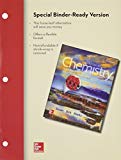
Concept explainers
Interpretation:
The ions or molecules present in the aqueous solution of the oxalic acid are to be determined. The identification of the ion that is present in the lowest concentration id to be done.
Concept Introduction:
The chemical substance which releases hydrogen ion in the solution is known as acidic substance. In such compounds, the hydrogen atom is attached to an electronegative atom. Thus, it readily loses hydrogen ions in the solution.
Explanation of Solution
Citric acid is a weak organic acid and furnishes hydronium ions according to its
The equations of the ionization of citric acid are:
It is apparent from the equations that the molecules present in the solution are
The molecules present in the solution are
Want to see more full solutions like this?
Chapter 13 Solutions
Combo: Loose Leaf for Introduction to Chemistry with Connect Access Card Chemistry with LearnSmart 1 Semester Access Card
- Classify each of the following acids as monoprotic, diprotic, or triprotic. a. HClO3 (chloric acid) b. HC3H5O4 (glyceric acid) c. H3C6H5O7 (citric acid) d. H3PO4 (phosphoric acid)arrow_forwardClassify each of the following substances as an acid, a base, or a salt. a. AlPO4 b. KOH c. HNO3 d. HC2H3O2arrow_forwardArrange the following 0.10 M aqueous solutions in order of increasing pH: HF, NaF, HNO3, and NaNO3.arrow_forward
- Write the chemical equation for the ionization of caffeine, a weak base. The chemical formula of caffeine is C8H10N4O2.arrow_forwardWhich of the terms weak, strong, monoprotic, diprotic, and triprotic characterize(s) each of the following acids? More than one term may apply in a given situation. a. H3PO4 b. H3PO3 c. HBr d. HC2H3O2arrow_forwardIndicate whether the first listed reactant in each of the following BrnstedLowry acidbase reactions is functioning as an acid or a base. a. F + H2O HF + OH b. HClO + H2O H3O+ + ClO c. H3PO4 + NH3 NH4+ + H2PO4 d. HNO2 + HS H2S + NO2arrow_forward
- The ion HPO42 is an amphiprotic ion. Write the chemical equation to describe its behavior in aqueous solution when it functions as a a. BrnstedLowry base b. BrnstedLowry acidarrow_forwardThe active ingredient formed by aspirin in the body is salicylic acid, C6H4OH(CO2H). The carboxyl group. (-CO2H) acts as a weak acid. The phenol group (an OH group bonded to an aromatic ring) also acts as an acid but a much weaker acid. List, in order of descending concentration, all of the ionic and molecular species present in a 0.001-M aqueous solution of C6H4OH(CO2H).arrow_forwardIndicate whether the first listed reactant in each of the following BrnstedLowry acidbase reactions is functioning as an acid or a base. a. HF + H2O H3O+ + F b. CN + H2O HCN + OH c. HCN + NO2 HNO2 + CN d. NH3 + HNO3 NH4+ + NO3arrow_forward
- Write chemical equations showing the individual proton-transfer steps that occur in aqueous solution for each of the following acids. a. H2CO3 (carbonic acid) b. H2C3H2O4 (malonic acid)arrow_forwardIndicate whether or not the two members of each of the following pairs of substances constitute a conjugate acidbase pair. a. HCl and Cl b. NH4+ and NH3 c. H2CO3 and CO32 d. H2PO4 and HPO42arrow_forwardClassify each of the acids in Problem 10-19 as a strong acid or a weak acid. a. HClO3 (chloric acid) b. HC3H5O4 (glyceric acid) c. H3C6H5O7 (citric acid) d. H3PO4 (phosphoric acid)arrow_forward
 General, Organic, and Biological ChemistryChemistryISBN:9781285853918Author:H. Stephen StokerPublisher:Cengage LearningChemistry: Matter and ChangeChemistryISBN:9780078746376Author:Dinah Zike, Laurel Dingrando, Nicholas Hainen, Cheryl WistromPublisher:Glencoe/McGraw-Hill School Pub Co
General, Organic, and Biological ChemistryChemistryISBN:9781285853918Author:H. Stephen StokerPublisher:Cengage LearningChemistry: Matter and ChangeChemistryISBN:9780078746376Author:Dinah Zike, Laurel Dingrando, Nicholas Hainen, Cheryl WistromPublisher:Glencoe/McGraw-Hill School Pub Co Chemistry & Chemical ReactivityChemistryISBN:9781133949640Author:John C. Kotz, Paul M. Treichel, John Townsend, David TreichelPublisher:Cengage Learning
Chemistry & Chemical ReactivityChemistryISBN:9781133949640Author:John C. Kotz, Paul M. Treichel, John Townsend, David TreichelPublisher:Cengage Learning Chemistry & Chemical ReactivityChemistryISBN:9781337399074Author:John C. Kotz, Paul M. Treichel, John Townsend, David TreichelPublisher:Cengage Learning
Chemistry & Chemical ReactivityChemistryISBN:9781337399074Author:John C. Kotz, Paul M. Treichel, John Townsend, David TreichelPublisher:Cengage Learning Chemistry: The Molecular ScienceChemistryISBN:9781285199047Author:John W. Moore, Conrad L. StanitskiPublisher:Cengage Learning
Chemistry: The Molecular ScienceChemistryISBN:9781285199047Author:John W. Moore, Conrad L. StanitskiPublisher:Cengage Learning Chemistry: Principles and PracticeChemistryISBN:9780534420123Author:Daniel L. Reger, Scott R. Goode, David W. Ball, Edward MercerPublisher:Cengage Learning
Chemistry: Principles and PracticeChemistryISBN:9780534420123Author:Daniel L. Reger, Scott R. Goode, David W. Ball, Edward MercerPublisher:Cengage Learning





